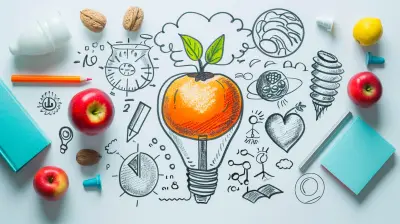The Role of Learning Styles in Test-Taking Strategies
8 August 2025
Ever felt like your brain is wired differently when it comes to studying? Maybe you read a textbook page ten times and still don’t understand a thing, but the moment you watch a YouTube video explaining the concept, it all makes sense. Or maybe you have to doodle in the margins of your notes to remember anything.
Well, guess what? You're not broken—you just have a learning style! And understanding your learning style is like unlocking a cheat code for test-taking. So, let’s break it all down, figure out what kind of learner you are, and find the best test-taking strategies for your brain. 
What's a Learning Style?
A learning style is basically how you process and retain information best. It’s why some people can listen to a lecture and absorb every word, while others need to take a million notes just to stay focused.Researchers typically categorize learning styles into these main types:
- Visual Learners (a.k.a. the "Show Me" Crowd)
- Auditory Learners (a.k.a. the "Tell Me" Folks)
- Kinesthetic Learners (a.k.a. the "Let Me Do It" Types)
Each of these learning styles comes with its own strengths, struggles, and secret weapons when it comes to test-taking. Let's break them down! 
Visual Learners: The Picture People 🎨
How They Learn Best
Visual learners process information through images, charts, graphs, and videos. If you're the type who prefers watching a 5-minute infographic over reading a 10-page article, this is probably you.Test-Taking Challenges
- Struggle with long blocks of text- May daydream if there's nothing visually engaging
- Have a hard time following verbal instructions without something to look at
Test-Taking Strategies for Visual Learners
✅ Make It Colorful – Use highlighters, colored pens, and mind maps to organize study material. Your brain loves colors!✅ Draw It Out – Doodle summaries of concepts, create flowcharts, or use diagrams. Even stick figures work—no Picasso skills required.
✅ Use Flashcards – Whether physical or digital (Anki, Quizlet, etc.), flipping through visual prompts can help with memory recall.
✅ Turn Notes into PowerPoint Slides – Reviewing information as if you're preparing to teach it helps lock it in. Bonus points if you make it look fancy.
✅ Watch Video Tutorials – YouTube, Khan Academy, and TED-Ed are your best friends. Find an animated explanation and watch concepts click into place. 
Auditory Learners: The Listeners 🎧
How They Learn Best
Auditory learners thrive on spoken words—lectures, podcasts, discussions, and even self-talk (yes, you're not crazy for talking to yourself!).Test-Taking Challenges
- May struggle with silent studying- Get distracted by background noise
- Find it hard to remember written material without hearing it
Test-Taking Strategies for Auditory Learners
✅ Read Aloud – If you’re studying, don’t just silently skim through notes—say them out loud. Pretend you’re narrating a documentary.✅ Record Yourself – Use voice memos to record key concepts and play them back whenever you’re doing chores or taking a walk.
✅ Use Mnemonics and Rhymes – Create silly rhymes, songs, or acronyms to remember information. Ever heard of PEMDAS? Exactly.
✅ Join a Study Group – Discussing concepts with others reinforces learning. Bonus: You sound super smart quoting facts in conversations.
✅ Listen to Podcasts & Audiobooks – If reading textbooks feels like a chore, find audio versions of the material. It's like Netflix for learning. 
Kinesthetic Learners: The Doers 🏃♂️
How They Learn Best
Kinesthetic learners need movement, hands-on activities, and real-world applications. Sitting still for hours? Torture.Test-Taking Challenges
- Struggle with traditional sit-down exams- Have trouble staying focused during long periods of study
- Remember things better when they involve physical action
Test-Taking Strategies for Kinesthetic Learners
✅ Use Hands-On Learning – If possible, turn study sessions into hands-on experiences (labs, experiments, role-playing scenarios).✅ Move While Studying – Walk around, bounce a ball, or use a standing desk. Physical movement keeps your brain engaged.
✅ Act It Out – Pretend you’re a teacher explaining the material to someone else. Bonus points if you use props.
✅ Write and Rewrite – The actual act of writing (not typing) helps reinforce concepts in your brain. So grab a notebook and rewrite key points.
✅ Study in Short Bursts – Break study time into 20-30 minute sessions with physical activity in between. Think of it like studying in sprints instead of a marathon.
What If You're a Mix?
Most people aren’t just one type of learner—they’re a mix of a couple, or even all three! If that’s you, congratulations! You have a buffet of strategies to pick from.Try different techniques and see what works best. Maybe you like to listen to audiobooks while doodling notes. Or maybe you switch between videos and hands-on projects. The key is finding what clicks for you.
Matching Learning Styles to Test Formats
Now that you know your learning style, let’s talk about matching it to different types of exams.📖 Written Exams (Essays, Long Answer)
- Visual Learners: Use structured outlines, charts, and diagrams to organize thoughts before writing.- Auditory Learners: Say your essay out loud before writing it to structure your arguments.
- Kinesthetic Learners: Use sticky notes or flashcards to move ideas around physically before writing.
📚 Multiple-Choice Tests
- Visual Learners: Use elimination strategies and underline keywords in the question.- Auditory Learners: Read the question aloud (if allowed) or subvocalize it in your head.
- Kinesthetic Learners: Tap your fingers or use a subtle movement to stay focused.
🗣 Oral Exams & Presentations
- Visual Learners: Use slides or cue cards with images.- Auditory Learners: Practice by speaking in front of a mirror or with a friend.
- Kinesthetic Learners: Move around while rehearsing—pace, gesture, do your thing!
Final Thoughts
At the end of the day, test-taking isn’t just about cramming the night before (though let’s be real, we’ve all been there). Understanding how you learn best can make studying feel way less miserable—and maybe even a little fun.So, next time you’re gearing up for an exam, don’t just rely on the same old routine. Use strategies that cater to your learning style, and you'll be amazed at how much easier studying—and test-taking—can be.
Now go forth, study smart, and ace that test!
all images in this post were generated using AI tools
Category:
Learning StylesAuthor:

Olivia Lewis
Discussion
rate this article
1 comments
Kane McCool
Embrace the uniqueness of your learning style! Understanding how you absorb information can transform your test-taking strategies, boosting confidence and performance. Keep striving for success—your potential is limitless!
August 27, 2025 at 5:01 AM

Olivia Lewis
Thank you! Embracing our unique learning styles truly empowers us to enhance our test-taking strategies and unlock our full potential.


